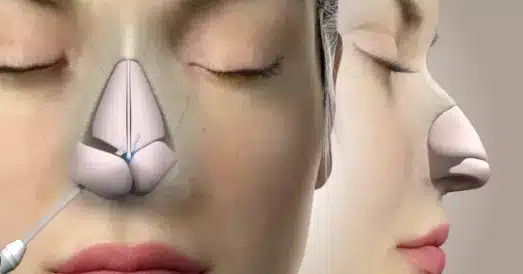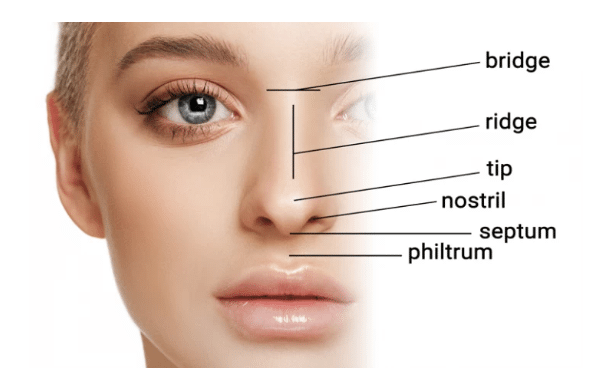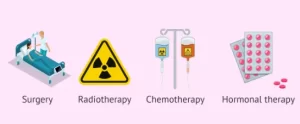In today’s world, where physical appearance is often emphasized, many individuals consider cosmetic procedures to enhance their features and boost their self-confidence. One such procedure that has gained popularity is the nose job, medically known as rhinoplasty.
A nose job involves reshaping the nose to achieve a more harmonious facial balance and address functional concerns. This article explores the concept of nose jobs, their various aspects, and important considerations for those considering the procedure.
Understanding Nose Jobs
A nose job, or rhinoplasty, is a surgical procedure performed by a plastic surgeon to modify the shape, size, or overall appearance of the nose. It can be both cosmetic and functional in nature. Cosmetic rhinoplasty focuses on enhancing the aesthetic appearance of the nose, while functional rhinoplasty aims to improve breathing and correct structural abnormalities that may hinder nasal function.
Different kinds of noses
Noses come in various shapes, sizes, and configurations, contributing to the diversity of human appearances. While it’s difficult to cover all the different variations, here are some common types of noses:
- Roman nose
- Snub nose
- Greek nose
- Hawk nose
- Nubian nose
- Bulbous nose
- Snorkel nose
- Crooked nose
- Upturned nose
- Flat nose
Reasons for Considering a Nose Job
There are several reasons why individuals may consider a nose job:
- Aesthetic Concerns Many people seek rhinoplasty to address perceived flaws or irregularities in their noses’ shape, size, or proportions. Common aesthetic concerns include a prominent hump on the bridge, a drooping or bulbous tip, wide nostrils, or an overall disproportionate appearance.
- Functional Issues Some individuals may have structural abnormalities in their noses that affect breathing, such as a deviated septum or nasal valve collapse. Rhinoplasty can correct these functional issues, improving airflow and overall nasal function.
- Injury or Trauma Nose jobs can also be performed to correct nasal deformities resulting from injuries or accidents. This may involve reconstructive rhinoplasty to restore the nose’s appearance and function.
The Rhinoplasty Procedure
A typical nose job involves several steps:
- Initial Consultation: During the initial consultation, you will discuss your goals and concerns with a plastic surgeon. They will evaluate your nasal structure, assess your facial harmony, and determine the most suitable approach for your unique case.
- Anesthesia: Rhinoplasty is usually performed under general anesthesia, ensuring a pain-free experience during the procedure.
- Incisions: Depending on the specific goals of your nose job, the surgeon will make incisions either inside the nostrils (closed rhinoplasty) or across the columella (the narrow strip of tissue between the nostrils, open rhinoplasty). The choice of technique depends on the complexity of the procedure and the surgeon’s preference.
- Reshaping the Nose: The surgeon will access the underlying nasal structure, including the bone and cartilage through the incisions.
- Closing the Incisions: The surgeon will carefully close the incisions with sutures once the necessary modifications are made.
- Recovery and Healing
Rhinoplasty, commonly known as a nose job, offers numerous aesthetic and functional benefits.
Benefits and risks of nose job
- Improved self-confidence: A nose job can enhance a person’s self-esteem by addressing dissatisfaction with their nose, leading to increased confidence in their appearance.
- Facial harmony: Rhinoplasty can help create a more balanced and proportionate facial appearance by reshaping the nose to complement other facial features better.
- Correcting nasal asymmetry: A nose job can address any asymmetry or irregularities in the nose, creating a more symmetrical and aesthetically pleasing appearance.
- Enhancing breathing function: In some cases, rhinoplasty can improve airflow by correcting structural abnormalities such as a deviated septum or nasal valve collapse, which can help alleviate breathing difficulties.
- Correcting birth defects or trauma-related deformities: Rhinoplasty can correct congenital nasal abnormalities or reconstruct the nose following injury or trauma.
- Resolving sinus problems: By addressing structural issues within the nose, such as a deviated septum, rhinoplasty can alleviate sinus-related symptoms and improve sinus drainage.
- Narrowing or widening the nasal bridge: Rhinoplasty can alter the width of the nasal bridge to achieve the desired aesthetic result.
- Refining the nasal tip: The shape, size, and projection can be modified through a nose job, allowing for a more defined or refined appearance.
- Correcting a drooping or upturned nasal tip: Rhinoplasty can adjust the position of the nasal tip, addressing issues such as drooping or excessive upturning.
- Correcting previous nasal surgery: In cases where individuals are unsatisfied with the results of a previous rhinoplasty, a revision nose job can be performed to achieve the desired outcome.
However, like any surgical procedure, a nose job has potential risks and complications. Here are seven risks to consider:
- Infection: As with any surgery, there is a risk of infection at the surgical site, although it is relatively rare.
- Bleeding: Some bleeding is expected during and after the procedure, but excessive bleeding can occur in rare cases.
- Scarring: Although efforts are made to minimize scarring, visible scarring is possible at the incision sites. However, skilled surgeons aim to make incisions in inconspicuous areas to minimize visibility.
- Nasal blockage: Following the surgery, there may be temporary nasal congestion or blockage due to swelling. In rare cases, this may persist and require additional treatment.
- Numbness or altered sensation: Some patients may experience temporary or permanent numbness or altered sensation in the nose or surrounding areas.
- Unsatisfactory results: Despite careful planning and execution, there is a possibility that the outcome of the surgery may not meet the patient’s expectations.
- Anesthesia risks: As with any surgical procedure, there are risks associated with anesthesia, including allergic reactions or adverse effects. These risks are generally low but should be considered.
Considerations and Expectations
Before undergoing a nose job, it is important to consider the following:
- Realistic Expectations: It is essential to have realistic expectations about the outcomes of a nose job. While the procedure can enhance the appearance and functionality of the nose, it may not result in perfection or completely change one’s facial appearance.
- Choosing a Qualified Surgeon: Selecting a skilled and experienced plastic surgeon is crucial for a successful outcome. Researching credentials, reviewing before and after photos, and seeking recommendations can help you find a reputable surgeon who understands your goals and has a proven track record of delivering satisfactory results.
- Potential Risks and Complications: Like any surgical procedure, rhinoplasty carries risks. These can include bleeding, infection, adverse reactions to anesthesia, scarring, asymmetry, and dissatisfaction with the results. Discussing these risks with your surgeon and understanding the potential outcomes can help you make an informed decision.
- Recovery and Downtime: Nose job recovery varies for each individual but typically involves some swelling, bruising, and discomfort. It may take several weeks or even months for the full results to be visible. Following your surgeon’s post-operative care instructions and allow yourself ample time to heal.

If you desire a more symmetrical nose, keep in mind that everyone’s face is asymmetric to some degree. Results may not be completely symmetric, although the goal is to create facial balance and correct proportion.AMERICAN SOCIETY OF PLASTIC SURGEONS
Summary
A nose job, or rhinoplasty, is a surgical procedure that can enhance both the appearance and functionality of the nose. Whether motivated by aesthetic concerns or functional issues, it is important to approach the decision with realistic expectations, careful consideration, and proper research. Consulting with a qualified plastic surgeon is crucial to understanding the procedure, its potential risks and benefits, and determining the most suitable approach for your specific goals and needs.
Fun fact: Did you know that rhinoplasty, commonly known as a nose job, is one of the most popular facial aesthetics procedures worldwide? It’s not just about enhancing beauty!
While many turn to nasal surgery for cosmetic reasons, others opt for it to address breathing issues or injuries. The magic touch of a skilled plastic surgeon can remarkably transform a person’s appearance or even boost their self-confidence through nose reshaping.
It’s fascinating how cosmetic procedures, especially related to the face, can have such profound impacts on an individual’s life!
FAQs:
- What is a nose job? A nose job, or rhinoplasty, is a surgical procedure to reshape or resize the nose.
- How long is the recovery? Recovery varies but typically takes 1-2 weeks to resume normal activities. Full recovery may take months.
- Are nose jobs permanent? Yes, the results of a nose job are generally permanent, though it may take time for final outcomes to be fully visible.




